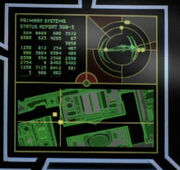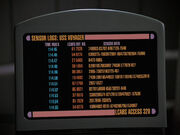m (Reverted edits by 77.103.72.127 (talk) to last version by Renegade54) |
m (lk fx) |
||
| Line 17: | Line 17: | ||
== Implementation on vessels == |
== Implementation on vessels == |
||
| − | The [[Starfleet]] vessel |
+ | The [[Starfleet]] vessel {{NX|Enterprise}} was equipped with a lateral [[sensor array]]. When [[Captain]] [[Jonathan Archer]] and [[Commander]] [[Charles Tucker III]] were inspecting the new [[prototype]] {{ShipClass|NX}} ship in an [[inspection pod]] during [[2151]], one of the components that Archer wanted to view was the lateral sensor array. ({{ENT|Broken Bow}}) |
In [[2370]], the [[Romulan]] [[D'deridex class|warbird]] [[IRW Terix|''Terix'']] performed a sensor scan of [[Asteroid gamma 601]] in the [[Devolin system]] with its lateral sensor array in hope to locate the {{USS|Pegasus}}. ({{TNG|The Pegasus}}) |
In [[2370]], the [[Romulan]] [[D'deridex class|warbird]] [[IRW Terix|''Terix'']] performed a sensor scan of [[Asteroid gamma 601]] in the [[Devolin system]] with its lateral sensor array in hope to locate the {{USS|Pegasus}}. ({{TNG|The Pegasus}}) |
||
Revision as of 00:57, 8 January 2012

A sensor reading of Deep Space 9 with real-time output on a Cardassian terminal
The term sensor, also referred to aboard starships as subspace sensors or sensor probes, was used to refer to any device that was used to scan, record, or otherwise observe any aspect of an environment surrounding a starship, space station, or person. This could be as simple a device as a manual camera or light sensor, or as complicated as the myriad devices designed to scan many aspects of the matter and energies of subspace, space, time, and stellar bodies that make up all of existence.
Use on vessels

USS Voyager's sensor readings at various time indexes
Sensors of various types played roles in almost every aspect of space travel. Every type of sensor from navigational sensors to ARA sensors created data to be interpreted by the vessels computers and operators. In most situations, the sensor data revealed information that was not apparent through other data collecting means, such as visual observations. One example of this was in the sensor data of the USS Voyager during one encounter with the Borg. Sensor readings from the ships active scans recorded "random subspace energy fluctuations" at various time index in the sensor logs. Closer examination of this data revealed the detections were not random fluctuations but communications to Seven of Nine, one of Voyager's crew. (VOY: "Dark Frontier")
Sensor scans
There were two basic types of sensor arrays employed: passive and active. A passive scan was less obtrusive than an active scan, and might not be detected by the subject being sensed. Also, sensors were divided into short- and long-range types. (Star Trek: The Motion Picture)
While there are many ways to mask a sensor scan, sensor screens were the most commonly used. (TOS: "The Mark of Gideon") One could also mask a sensor scan with certain materials, or radiation. (TNG: "Who Watches The Watchers", "The Pegasus") But to truly hide from a sensor scan, one would actually have to change one's molecular structure. (TOS: "Obsession")
In early 2368, when investigating the Phoenix Cluster, the lateral sensors of the USS Enterprise-D were booked solid for planetary observation. (TNG: "The Game")
Sensors were used by the Vahklas, a Vulcan civilian transport ship, which had left the planet Vulcan in approximately 2143. When Subcommander T'Pol was studying the Arachnid Nebula aboard the Vahklas in 2151, she was temporarily unable to scan the nebula's disodium layer, due to the fact that the transport ship's lateral sensors were out of alignment. (ENT: "Fusion")
Implementation on vessels
The Starfleet vessel Enterprise was equipped with a lateral sensor array. When Captain Jonathan Archer and Commander Charles Tucker III were inspecting the new prototype Template:ShipClass ship in an inspection pod during 2151, one of the components that Archer wanted to view was the lateral sensor array. (ENT: "Broken Bow")
In 2370, the Romulan warbird Terix performed a sensor scan of Asteroid gamma 601 in the Devolin system with its lateral sensor array in hope to locate the USS Pegasus. (TNG: "The Pegasus")
Template:ShipClass starships were equipped with high-resolution, multi-spectral sensors. (TNG: "Encounter at Farpoint")
Types of scans
- antiproton beam
- autonomic response analysis
- geological scan
- high-resolution scan
- passive high-resolution series
- internal scan
- long range sensor scan
- magneton scan
- navigational scan
- multiphasic scan
- subspace differential pulse
- Inverse tachyon pulse
- virtual positron imaging scan
